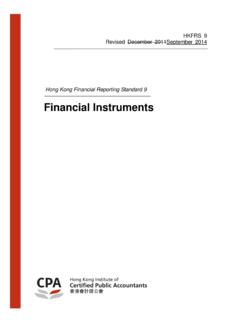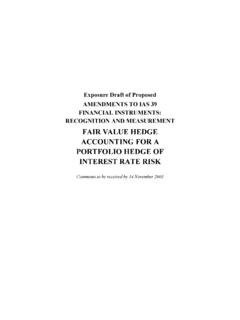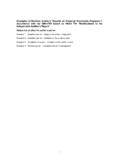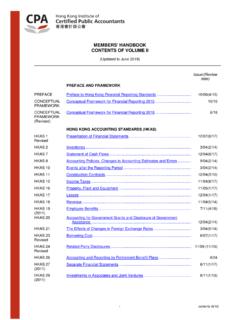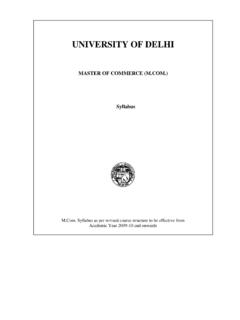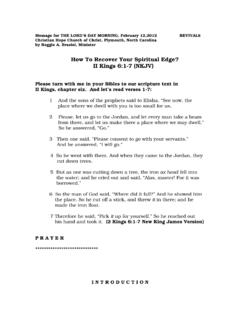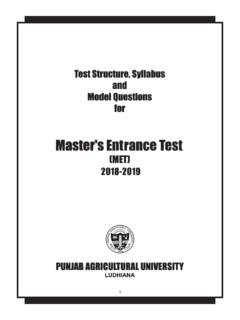Transcription of HKAS 37 Provisions, Contingent Liabilities and Contingent ...
1 provisions , Contingent Liabilities and Contingent Assets Hong Kong Accounting Standard 37 HKAS 37 Revised March 2010 November 2016 Effective for annual periods beginning on or after 1 January 2005 HKAS 37 Copyright 2 COPYRIGHT Copyright 2016 Hong Kong Institute of Certified Public Accountants This Hong Kong Financial Reporting Standard contains International Accounting Standards Committee Foundation copyright material. Reproduction within Hong Kong in unaltered form (retaining this notice) is permitted for personal and non-commercial use subject to the inclusion of an acknowledgment of the source. Requests and inquiries concerning reproduction and rights for commercial purposes within Hong Kong should be addressed to the Director, Operation and Finance, Hong Kong Institute of Certified Public Accountants, 37/F., Wu Chung House, 213 Queen's Road East, Wanchai, Hong Kong. All rights in this material outside of Hong Kong are reserved by International Accounting Standards Committee Foundation.
2 Reproduction of Hong Kong Financial Reporting Standards outside of Hong Kong in unaltered form (retaining this notice) is permitted for personal and non-commercial use only. Further information and requests for authorisation to reproduce for commercial purposes outside Hong Kong should be addressed to the International Accounting Standards Committee Foundation at HKAS 37 (November 2004 March 2010) Copyright 3 Contents paragraphs INTRODUCTION IN1-IN23 HONG KONG ACCOUNTING STANDARD 37 provisions , Contingent Liabilities AND Contingent ASSETS OBJECTIVE SCOPE 1-9 DEFINITIONS 10-13 provisions and other Liabilities 11 Relationship between provisions and Contingent Liabilities 12-13 RECOGNITION 14-35 provisions 14-26 Present obligation 15-16 Past event 17-22 Probable outflow of resources embodying economic benefits 23-24 Reliable estimate of the obligation 25-26 Contingent Liabilities 27-30 Contingent assets 31-35 MEASUREMENT 36-52 Best estimate 36-41 Risk and uncertainties 42-44 Present value 45-47 Future events 48-50 Expected disposals of assets 51-52 REIMBURSEMENTS 53-58 CHANGES IN provisions 59-60 USE OF provisions 61-62 APPLICATION OF THE RECOGNITION AND MEASUREMENT RULES 63-83 Future operating losses 63-65 Onerous contracts 66-69 Restructuring 70-83 DISCLOSURE 84-92 TRANSITIONAL provisions 93 EFFECTIVE DATE 95-96 HKAS 37 (December 2007)
3 Copyright 4 APPENDICES A. Tables provisions , Contingent Liabilities , Contingent assets and reimbursements B. Decision tree C. Examples: recognition D. Examples: disclosure E. Comparison with International Accounting Standards Hong Kong Accounting Standard 37 provisions , Contingent Liabilities and Contingent Assets (HKAS 37) is set out in paragraphs 1-96. All the paragraphs have equal authority. HKAS 37 should be read in the context of its objective, the Preface to Hong Kong Financial Reporting Standards and the Framework for the Preparation and Presentation of Financial Statements. HKAS 8 Accounting Policies, Changes in Accounting Estimates and Errors provides a basis for selecting and applying accounting policies in the absence of explicit guidance. HKAS 37 (March 2010) Copyright 5 Introduction IN1 HKAS 37 prescribes the accounting and disclosure for all provisions , Contingent Liabilities and Contingent assets, except: (a) those resulting from financial instruments that are carried at fair value; (b) those resulting from executory contracts, except where the contract is onerous.
4 Executory contracts are contracts under which neither party has performed any of its obligations or both parties have partially performed their obligations to an equal extent; (c) those arising in insurance entities from contracts with policyholders; or (d) those covered by another Standard. provisions IN2 The Standard defines provisions as Liabilities of uncertain timing or amount. A provision should be recognised when, and only when : (a) an entity has a present obligation (legal or constructive) as a result of a past event; (b) it is probable (ie more likely than not) that an outflow of resources embodying economic benefits will be required to settle the obligation; and (c) a reliable estimate can be made of the amount of the obligation. The Standard notes that it is only in extremely rare cases that a reliable estimate will not be possible. IN3 The Standard defines a constructive obligation as an obligation that derives from an entity s actions where : (a) by an established pattern of past practice, published policies or a sufficiently specific current statement, the entity has indicated to other parties that it will accept certain responsibilities; and (b) as a result, the entity has created a valid expectation on the part of those other parties that it will discharge those responsibilities.
5 IN4 In rare cases, for example in a lawsuit, it may not be clear whether an entity has a present obligation. In these cases, a past event is deemed to give rise to a present obligation if, taking account of all available evidence, it is more likely than not that a present obligation exists at the end of the reporting period. An entity recognises a provision for that present obligation if the other recognition criteria described above are met. If it is more likely than not that no present obligation exists, the entity discloses a Contingent liability, unless the possibility of an outflow of resources embodying economic benefits is remote. IN5 The amount recognised as a provision should be the best estimate of the expenditure required to settle the present obligation at the end of the reporting period, in other words, the amount that an entity would rationally pay to settle the obligation at the end of the reporting period or to transfer it to a third party at that time.
6 IN6 The Standard requires that an entity should, in measuring a provision: (a) take risks and uncertainties into account. However, uncertainty does not justify the creation of excessive provisions or a deliberate overstatement of Liabilities ; (b) discount the provisions , where the effect of the time value of money is material, using a pre-tax discount rate (or rates) that reflect(s) current market assessments of the time value of money and those risks specific to the liability that have not been reflected in the best estimate of the expenditure. Where discounting is used, the increase in the provision due to the passage of time is recognised as an interest expense; (c) take future events, such as changes in the law and technological changes, into account where there is sufficient objective evidence that they will occur; and HKAS 37 (March 2010) Copyright 6 (d) not take gains from the expected disposal of assets into account, even if the expected disposal is closely linked to the event giving rise to the provision.
7 IN7 An entity may expect reimbursement of some or all of the expenditure required to settle a provision (for example, through insurance contracts, indemnity clauses or suppliers warranties). An entity should: (a) recognise a reimbursement when, and only when, it is virtually certain that reimbursement will be received if the entity settles the obligation. The amount recognised for the reimbursement should not exceed the amount of the provision; and (b) recognise the reimbursement as a separate asset. In the statement of comprehensive income, the expense relating to a provision may be presented net of the amount recognised for a reimbursement. IN8 provisions should be reviewed at the end of each reporting period and adjusted to reflect the current best estimate. If it is no longer probable that an outflow of resources embodying economic benefits will be required to settle the obligation, the provision should be reversed.
8 IN9 A provision should be used only for expenditures for which the provision was originally recognised. provisions specific applications IN10 The Standard explains how the general recognition and measurement requirements for provisions should be applied in three specific cases: future operating losses ; onerous contracts ; and restructurings. IN11 provisions should not be recognised for future operating losses. An expectation of future operating losses is an indication that certain assets of the operation may be impaired. In this case, an entity tests these assets for impairment under HKAS 36 Impairment of Assets. IN12 If an entity has a contract that is onerous, the present obligation under the contract should be recognised and measured as a provision. An onerous contract is one in which the unavoidable costs of meeting the obligations under the contract exceed the economic benefits expected to be received under it.
9 IN13 The Standard defines a restructuring as a programme that is planned and controlled by management, and materially changes either: (a) the scope of a business undertaken by an entity; or (b) the manner in which that business is conducted. IN14 A provision for restructuring costs is recognised only when the general recognition criteria for provisions are met. In this context, a constructive obligation to restructure arises only when an entity: (a) has a detailed formal plan for the restructuring identifying at least: (i) the business or part of a business concerned; (ii) the principal locations affected; (iii) the location, function, and approximate number of employees who will be compensated for terminating their services; (iv) the expenditures that will be undertaken; and (v) when the plan will be implemented; and (b) has raised a valid expectation in those affected that it will carry out the restructuring by starting to implement that plan or announcing its main features to those affected by it.
10 HKAS 37 (March 2010) Copyright 7 IN15 A management or board decision to restructure does not give rise to a constructive obligation at the end of the reporting period unless the entity has, before the end of the reporting period: (a) started to implement the restructuring plan; or (b) communicated the restructuring plan to those affected by it in a sufficiently specific manner to raise a valid expectation in them that the entity will carry out the restructuring. IN16 Where a restructuring involves the sale of an operation, no obligation arises for the sale until the entity is committed to the sale, ie there is a binding sale agreement. IN17 A restructuring provision should include only the direct expenditures arising from the restructuring, which are those that are both: (a) necessarily entailed by the restructuring; and (b) not associated with the ongoing activities of the entity. Thus, a restructuring provision does not include such costs as: retraining or relocating continuing staff; marketing; or investment in new systems and distribution networks.
